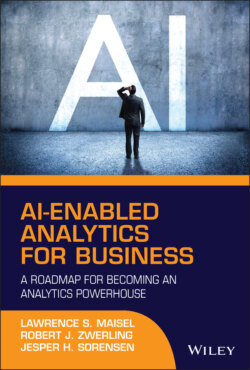Читать книгу AI-Enabled Analytics for Business - Lawrence S. Maisel - Страница 19
COMPETITIVENESS
ОглавлениеToday’s competitive landscape requires the adoption of analytics for business to remain competitive, growing, and profitable. The business that can plan better, wins! For example, if Company A can more accurately forecast its demand, then it gains efficiency over costs and use of capital to better allocate to grow its markets; whereas Company B, which has failed to better forecast demand, loses market share due to the inability to fulfill demand or inefficiency in its costs that leads to higher prices.
This example seems obvious, yet the stampede to incorporate AI-enabled analytics in business is slow to develop, often from the lack of people skills and analytics tools, but primarily from an executive’s perspective to under-value the benefits from AI. Until executives understand and believe in the value from AI, business will confront massive amounts of data with spreadsheets, which is akin to taking a cross-country trip on a tricycle. Fine if you have the time—but you don’t.
Unfortunately, too many executives do not appreciate or understand the value of AI and analytics to solve business problems, such as optimizing areas of the business and actions that can be derived from insights to improve the business. This is due to several factors, including lack of executive training on analytics, no advocate emerging to make a compelling case for analytics, and, as is often true with other innovations, executives who are risk-averse about investing in what they do not understand or accepting a risk of failure.
The lessons learned from prior business technology revolutions have taught that the need to enter the modern digital transformation era is a requirement and not an option. In times past, businesses that have not evolved with the changes have perished or, worse, become insignificant players in their industry segment.
Think IBM, once the preeminent and dominant name in computers in the twentieth century, is little spoken of in the 2020s. Still a $70 billion company, IBM is not a point of presence in Silicon Valley, which has bred competitors to take mindshare when it comes to computer innovation and relevance. Think too of Kodak, born in the 1880s, a onetime “blue-chip” company that held 90% of the film and 85% of the camera market in the United States. As late as 1996, it was a $16 billion company with 145,000 employees. But the switch to digital cameras and smartphones decimated Kodak, and by 2012, Kodak filed for bankruptcy protection.2
In comparing the 1955 Fortune 500 list of companies to the 2019 list, there remain only 52 companies. The penalty for not recognizing the emerging digital transformation era will be just as severe. Companies like Blackberry, Nokia, and Motorola are shadows of the prevailing players they once were in the market they shaped. Conversely, companies like Amazon and Netflix have led the way and dominated with AI and analytics. Note, though, that adverse consequences are not limited to large companies and are equally applicable to companies of any size or industry, and public, private, profit, or non-profit.
The executive who does not realize the value from analytics or fails to adopt will be replaced by an executive who can deliver insights for data-driven decisions. This is inevitable because executives who fail to do so will endanger their company’s performance and competitive position.
